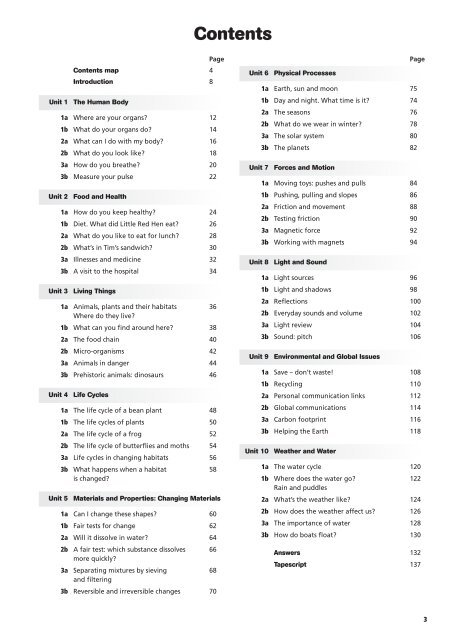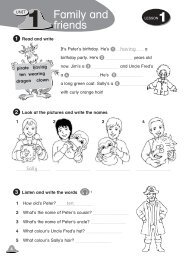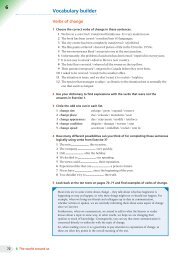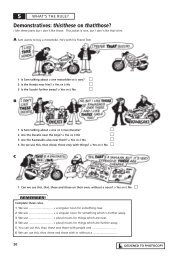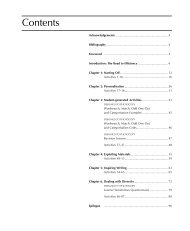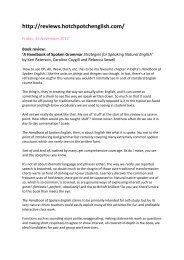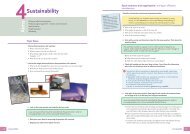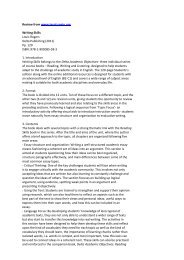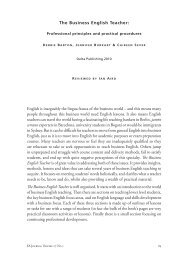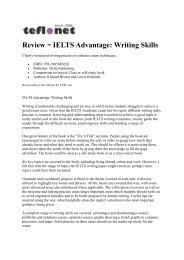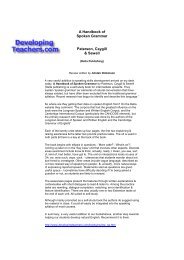Contents - Delta Publishing
Contents - Delta Publishing
Contents - Delta Publishing
Create successful ePaper yourself
Turn your PDF publications into a flip-book with our unique Google optimized e-Paper software.
<strong>Contents</strong><br />
<strong>Contents</strong> map 4<br />
Introduction 8<br />
Unit 1 The Human Body<br />
1a Where are your organs? 12<br />
1b What do your organs do? 14<br />
2a What can I do with my body? 16<br />
2b What do you look like? 18<br />
3a How do you breathe? 20<br />
3b Measure your pulse 22<br />
Unit 2 Food and Health<br />
1a How do you keep healthy? 24<br />
1b Diet. What did Little Red Hen eat? 26<br />
2a What do you like to eat for lunch? 28<br />
2b What’s in Tim’s sandwich? 30<br />
3a Illnesses and medicine 32<br />
3b A visit to the hospital 34<br />
Unit 3 Living Things<br />
1a Animals, plants and their habitats 36<br />
Where do they live?<br />
1b What can you find around here? 38<br />
2a The food chain 40<br />
2b Micro-organisms 42<br />
3a Animals in danger 44<br />
3b Prehistoric animals: dinosaurs 46<br />
Unit 4 Life Cycles<br />
1a The life cycle of a bean plant 48<br />
1b The life cycles of plants 50<br />
2a The life cycle of a frog 52<br />
2b The life cycle of butterflies and moths 54<br />
3a Life cycles in changing habitats 56<br />
3b What happens when a habitat 58<br />
is changed?<br />
Page<br />
Unit 5 Materials and Properties: Changing Materials<br />
1a Can I change these shapes? 60<br />
1b Fair tests for change 62<br />
2a Will it dissolve in water? 64<br />
2b A fair test: which substance dissolves 66<br />
more quickly?<br />
3a Separating mixtures by sieving 68<br />
and filtering<br />
3b Reversible and irreversible changes 70<br />
Unit 6 Physical Processes<br />
1a Earth, sun and moon 75<br />
1b Day and night. What time is it? 74<br />
2a The seasons 76<br />
2b What do we wear in winter? 78<br />
3a The solar system 80<br />
3b The planets 82<br />
Unit 7 Forces and Motion<br />
1a Moving toys: pushes and pulls 84<br />
1b Pushing, pulling and slopes 86<br />
2a Friction and movement 88<br />
2b Testing friction 90<br />
3a Magnetic force 92<br />
3b Working with magnets 94<br />
Unit 8 Light and Sound<br />
1a Light sources 96<br />
1b Light and shadows 98<br />
Page<br />
2a Reflections 100<br />
2b Everyday sounds and volume 102<br />
3a Light review 104<br />
3b Sound: pitch 106<br />
Unit 9 Environmental and Global Issues<br />
1a Save – don’t waste! 108<br />
1b Recycling 110<br />
2a Personal communication links 112<br />
2b Global communications 114<br />
3a Carbon footprint 116<br />
3b Helping the Earth 118<br />
Unit 10 Weather and Water<br />
1a The water cycle 120<br />
1b Where does the water go? 122<br />
Rain and puddles<br />
2a What’s the weather like? 124<br />
2b How does the weather affect us? 126<br />
3a The importance of water 128<br />
3b How do boats float? 130<br />
Answers 132<br />
Tapescript 137<br />
3
Level<br />
Topic<br />
Aims<br />
Cross-curriculum links<br />
Unit 1 • The Human Body<br />
1.1a Where are your organs? To Identify and locate some internal organs. Literacy • Science<br />
To revise known parts of the body.<br />
Art & Design • Music<br />
1.1b What do your To understand the functions of the main body organs. Literacy • Science<br />
organs do?<br />
Art & Design • Music<br />
1.2a Muscles To learn the location and main functions of the main muscles of the body. Literacy • Science<br />
What can I do with To revise known parts of the body. Art & Design<br />
my body?<br />
1.2b What do you look like? To revise facial features, colours and clothes. Maths • Literacy<br />
To describe eyes, hair, height, clothes, etc.<br />
Science • Art & Design<br />
To observe how people are the same/different.<br />
1.3a How do you breathe? To learn about the circulatory system. Science • Literacy<br />
To revise organs of the body.<br />
Art & Design<br />
1.3b Measure your pulse To understand the effects of exercise and rest on the pulse rate. Literacy • Science<br />
To make predictions.<br />
Maths • PE<br />
To make a fair test.<br />
To record results.<br />
Unit 2 • Food and Health<br />
2.1a How do you keep To recognise the importance of exercise and healthy diet to look Literacy • Maths<br />
healthy? after our body. Art & Design<br />
2.1b Diet. To understand the importance of a healthy diet. Literacy • Science<br />
What did Little<br />
To understand the conditions needed for plants to grow.<br />
Red Hen eat?<br />
To revise main meals of the day and farm animals.<br />
2.2a What do you like to To understand and design a healthy diet. Literacy • Science<br />
eat for lunch? To understand the function of carbohydrates, proteins, fats and fibre. Maths • Art & Design<br />
2.2b What’s in Tim’s To identify the main meals of the day. Literacy • Science<br />
sandwich? To recognise the difference between and compare pupils’ Maths • Art & Design<br />
traditional meals and British food.<br />
2.3a Illnesses and medicine To be aware of health problems as a consequence of not looking Literacy • Science<br />
after our bodies.<br />
PE • Art & Design<br />
To be aware of the importance of taking precautions to stop<br />
the spread of disease.<br />
To understand the use of medicines and drugs.<br />
2.3b A visit to the hospital To learn about how accidents can happen, what to do when an accident Literacy • Science<br />
has happened and how we can prevent accidents.<br />
Music • Drama<br />
To learn how to take responsibility for their own health and safety.<br />
Unit 3 • Living Things<br />
3.1a Animals, plants To establish links between different animals and plants and their habitats. Science • PE<br />
and their habitats<br />
Music • Art & Design<br />
Where do they live?<br />
3.1b What can you find To observe conditions in a local habitat and record the animals seen. Geography • Science<br />
around here? To learn that animals are suited to their environments. Maths • Art & Design<br />
To understand the difference between vertebrates and invertebrates.<br />
4
Level<br />
Topic<br />
Aims<br />
Cross-curriculum links<br />
3.2a The food chain Order living things in simple food chains. Literacy • Science<br />
Maths • Art & Design<br />
3.2b Micro-organisms To identify micro-organisms as living things. Literacy • Science<br />
To recognise their distinguishing features.<br />
Maths<br />
To recognise their beneficial or harmful properties.<br />
3.3a Animals in danger To identify living things that are rare and the problems of survival. Literacy • Science<br />
Maths • Geography<br />
3.3b Prehistoric animals: To identify living things that are now extinct. Literacy • History<br />
dinosaurs<br />
Maths • Art & Design<br />
Unit 4 • Life Cycles<br />
4.1a The life cycle of To recognise and understand the life cycle of a bean plant. PE • Literacy • Maths<br />
a bean plant<br />
ICT • Art & Design<br />
4.1b The life cycles of plants To use knowledge of one plant’s life cycle to predict, recognise and Literacy • Maths<br />
understand the life cycle of other plants.<br />
ICT • Art & Design<br />
4.2a The life cycle of a frog To recognise and understand the stages in the life cycle of a frog. Literacy • Music<br />
Art & Craft<br />
4.2b The life cycle of To recognise and understand the stages in the life cycle of butterflies Literacy • Maths<br />
butterflies and moths and moths. Art & Design • CTD<br />
4.3a Life cycles in changing Identify ways in which animal life cycles are adapted to changing habitats. Science • Literacy<br />
habitats Explore information texts. Geography • ICT<br />
Environmental Science<br />
4.3b What happens when To recognise the ways life cycles are affected by environmental changes. Science • Literacy<br />
a habitat is changed? To understand the difference between fact and opinion. Geography • ICT<br />
Environmental Science<br />
Unit 5 • Materials and Properties: Changing Materials<br />
5.1a Can I change these To understand that the shape of some objects can be changed because Literacy • Geography<br />
shapes? of the properties of their materials. Maths • Art & Design<br />
5.1b Fair tests for change To understand the meaning of a fair test. Literacy • Geography<br />
To be able to predict results of a fair test to change everyday materials Art & Design • History<br />
by heating.<br />
ICT • Food Technology<br />
5.2a Will it dissolve in water? To understand that some substances dissolve in water while others Literacy • History<br />
do not.<br />
Geography • PSHE<br />
5.2b A fair test: which To be able to design and carry out a fair test. History • Literacy<br />
substance dissolves To find out if salt or sugar dissolves more quickly in cold water. PSHE<br />
more quickly?<br />
5.3a Separating mixtures To apply knowledge of the characteristics of materials so as to be able Geography<br />
by sieving and filtering to separate them from mixtures. Environmental Science<br />
5.3b Reversible and To be able to use the knowledge of materials’ different properties to Literacy • Science<br />
irreversible changes identify reversible and irreversible changes. Food Technology<br />
5
Level<br />
Topic<br />
Aims<br />
Cross-curriculum links<br />
Unit 6 • Physical Processes<br />
6.1a Earth, sun and moon To understand that the sun, the Earth and the moon are spherical. Literacy • PE<br />
To understand that Earth orbits the sun and the moon orbits Earth.<br />
Maths • Art & Design<br />
6.1b Day and night To understand how day and night are related to the turning of the Earth Literacy • PE<br />
What time is it? on its axis. Maths • Art & Design<br />
To raise awareness of time zones.<br />
6.2a The seasons To understand that the Earth tilts as it orbits the sun, giving us the seasons. Literacy • PE<br />
Maths • Art & Design<br />
6.2b What do we wear To understand how humans adapt to changes in climate and the weather. Science • Maths<br />
in winter?<br />
Art & Design • Music<br />
6.3a The solar system To identify the planets and main elements of the solar system. Science • Maths<br />
Art & Design • PE<br />
6.3b The planets To identify the planets and understand the differences between them. Science • Maths<br />
Literacy<br />
Unit 7 • Forces and Motion<br />
7.1a Moving toys: To identify pushes and pulls as forces. Literacy • Drama<br />
pushes and pulls To understand how toys can be moved by pushing or pulling. History • Art & Design<br />
7.1b Pushing, pulling To understand how slopes affect pushing and pulling. Literacy • Drama<br />
and slopes<br />
History • Art & Design<br />
7.2a Friction and movement To recognise the effect of friction on the movement of objects. Literacy • History<br />
Geography • PE<br />
7.2b Testing friction To investigate the effect of friction on the movement of objects. Literacy • ICT<br />
PSHE<br />
7.3a Magnetic force To understand that when magnets attract and repel, these are forces. Geography • Maths<br />
Art & Design<br />
7.3b Working with magnets To investigate magnetic forces. Geography • Maths<br />
Art & Design<br />
Unit 8 • Light and Sound<br />
8.1a Light sources To recognise natural and man-made light sources. Literacy • Science<br />
Music • Art & Design<br />
8.1b Light and shadows To understand that shadows appear when light is blocked. Literacy • Science<br />
PSHE • Drama<br />
Art & Design<br />
8.2a Reflections To investigate reflections in mirrors and shiny surfaces. Literacy • Maths<br />
PSHE • Drama/PE<br />
Art & Design<br />
8.2b Everyday sounds To understand that sound is made when objects vibrate. Literacy • Music<br />
and volume<br />
Drama • PSHE<br />
6
Level<br />
Topic<br />
Aims<br />
Cross-curriculum links<br />
8.3a Light review To revise and extend scientific vocabulary to describe the properties Literacy • Drama/PE<br />
of light.<br />
Art & Design<br />
8.3b Sound: pitch To investigate how pitch is related to size in a musical instrument. Literacy • Maths<br />
Music • Art & Design<br />
Unit 9 • Environmental and Global Issues<br />
9.1a Save – don’t waste! To identify ways of conserving the Earth’s resources. Literacy • Science<br />
Geography • History<br />
Art & Design<br />
9.1b Recycling To identify items that can be recycled. Literacy • Science<br />
Geography • Maths<br />
Art & Design<br />
9.2a Personal communication To compare ways of communicating. Literacy • Geography<br />
links To be able to select appropriate ways of communicating. History • PSHE<br />
9.2b Global communications To investigate different means of global communication and to identify Literacy • Geography<br />
facts and opinions in news reports.<br />
Drama<br />
9.3a Carbon footprint To identify ways in which individuals can make lifestyle changes which Science • Geography<br />
will reduce their impact on the Earth’s resources.<br />
ICT • Maths<br />
Art & Design<br />
9.3b Helping the Earth To understand that everyone is part of a global community. Literacy • Science<br />
To discuss how individual actions can affect the Earth.<br />
Geography • PSHE<br />
Citizenship<br />
Unit 10 • Weather and Water<br />
10.1a The water cycle To be able to identify and sequence the key components of the Maths • Literacy<br />
water cycle.<br />
Music<br />
10.1b Where does the To understand the importance of water conservation. Geography • Science<br />
water go? To understand the processes of evaporation and condensation. Literacy • Art & Design<br />
Rain and puddles<br />
10.2a What’s the weather To develop understanding of local and wider weather patterns. Geography • Music<br />
like? To understand that extreme weather is sometimes due to climate change. Literacy • Art & Design<br />
10.2b How does the weather To recognise different climatic zones. Geography • Maths<br />
affect us? To understand how varying weather conditions affect or change the Literacy • Art & Design<br />
landscape and its inhabitants.<br />
10.3a The importance of To appreciate the importance of water in our daily lives. Maths • Music<br />
water To recognise properties of water as a valuable element. Art & Design • Science<br />
10.3b How do boats float? To understand sinking and floating. Maths • Literacy<br />
Art & Design • Science<br />
7


